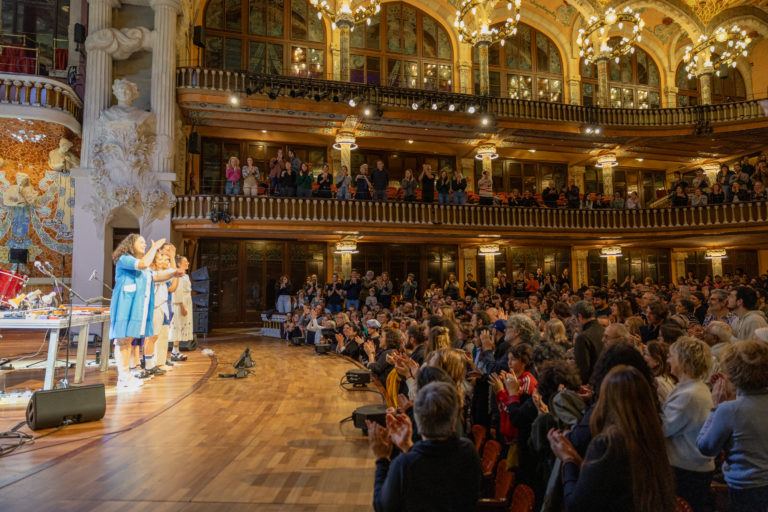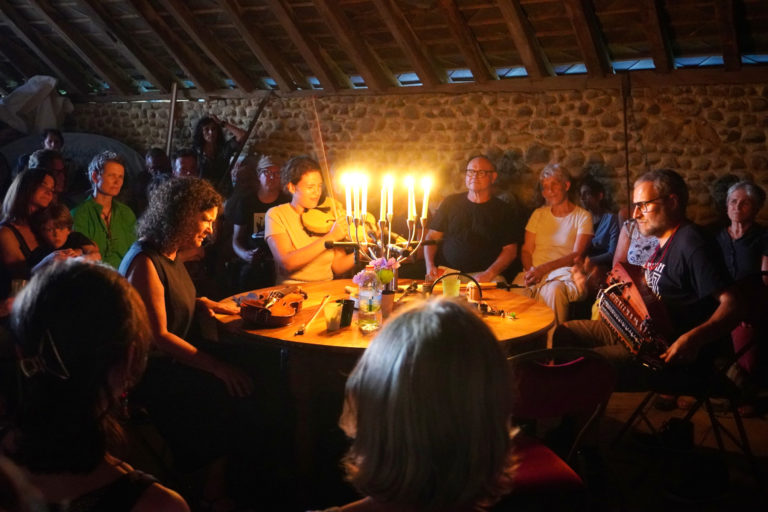Author: Thomas Guillot
While the Catalan cultural sector benefits from the constant support of its cultural institutions, its French-Occitan neighbour is enjoying a surge in popularity regardless of its independence. Deep down, the subsistence of each music scene is connected to the level of recognition of their languages and cultures. In parallel, a great deal of bands and collectives are trying to modernise traditional music, while adopting new ways to create, collaborate, and get paid. Building on several interviews, this article analyses the support systems from each side of the Pyrenees and dreams of possible interconnections between the two music scenes.

4132314 at the Palau de la Música Catalana in Barcelona, Spain – © Leandra Ruiz
Catalan Culture: Protected by Regional Institutions
Catalan is still going strong with more than 9 million speakers. More than that, Catalan is the most spoken language in Europe not recognised as one of the 24 official languages of the EU. To be integrated as such has been a priority for a while. Pedro Sanchez’s re-election was a new occasion to talk about it when the elected government granted Galician, Basque, and Catalan official parliamentary status in Spain. This is unlikely to happen at the European level.
Last year, for the Primavera Sound in Barcelona, the headliner Rosalía casually spoke Catalan in front of 60,000 international and local fans. Rosalía is a big star, but behind her a whole scene of Catalan music is striving. “In recent years, there has been a wave of musicians inspired by their folkloric roots to create something new,” says Lluc Silvestre, music coordinator at the Ramon Llull Institute. He starts listing Tarta Relena, los Sara Fontan, Raül Refree, Marina Herlop, Júlia Colom… Lila Fraysse, an Occitan musician, agrees: “I have always been fascinated by the political power of the Catalan language. Culturally there are lots of things happening in Catalan, without necessarily being politicised.” On the other hand, the music industry is an economic focus for Catalonia's development strategy, generating 854 million euros in annual revenues, only shy of a hundred million to arrive at the same level of the entire French music industry (968 M€ in 2023).
“The role of the Institute is to support performing arts that are part of Catalan culture,” explains Lluc Silvestre. On their website, you can find an extensive list of subventions available for all types of cultural organisations. “The Ramon Llull Institute has been helping us a lot: they provide good conditions for artists to go abroad.” This is Elena Ros, from Tarta Relena. In 2023 alone, the Ramon Llull Institute granted funds for 120 musical representations in 50 different countries. A unanimous support that is hard to match when we have a look on the other side of the Pyrenees.

Marina Herlop in Mexico – © Diego Figueora, Ramon Llull Institute
Occitan Music: Thriving Despite a Lack of Recognition
Occitan, on the other hand, is classified as a vulnerable language by UNESCO. There are no official statistics on the number of Occitan locutors–sources go from half a million to 2 million. “Occitania is a broad linguistic territory going from Bordeaux to Valence, down to Nice,” explains Erwan Billon from Barrut, a vocal group based in Montpellier. “We are part of the last generation to still experience what we call the vergonha, the shame of being Occitan,” explains Lila Fraysse. “Our parents have been educated to reject their culture. Luckily, the new generations have no barrier preventing them from learning the language. They think it’s great that we sing in Occitan.” The “complicated relationship between France's central power and the many cultures of French territory” as she phrased it, was discussed by every Occitan musician interviewed.
Nevertheless, Occitan music is more popular than ever. Bands like San Salvador, Sourdure, Super Parquet, or Cocanha are getting recognition outside of the traditional circles. “Becoming fashionable wasn’t planned. We didn’t expect we would have articles in Libération.” This is Laurent Moulédous, director of Hart Brut, an independent production company through which they apply for regional fundings for all the bands they represent, and the CERC (Centre de Creacion Musicau), aiming to become the first centre specialised in traditional music creation to receive a national agreement. He’s also the president of Pagans, France’s essential independent record label dedicated to traditional music. About these organisations, Lila Fraysse declares: “they helped us structure ourselves in our own company and explained how cultural engineering works.” Another of their support systems, the National Federation of Traditional Dances and Music (FAMDT), an independent union built by artists, is growing. MODAL is their new media featuring podcasts, YouTube channels, and web articles. Their most recent success is Tambours Battantes, a podcast series presenting female artists in traditional music. “We had to find fundings to create a media focusing on our aesthetics,” says Laurent Moulédous, part of FAMDT’s board for the last 10 years.
“There is a willingness, since the creation of the larger regions [in 2015], to support creation in Occitan” precises Gabriel Durif from San Salvador, a choir based in Corrèze, who created their own independent label. Indeed, the Occitania region is supporting both Catalan and Occitan musics through a summer festival called Total Festum, supporting local associations to organise concerts. “But we, as San Salvador, avoid this type of events, because we find it confining. We are booked in festivals because we reach people, whether they speak Occitan or not," Gabriel Durif adds. A feeling shared by Yann Gourdon, member of the collective La Nòvia, commissioned and subsidised by diverse territorial institutions: “I think [they] considered that La Nòvia's aesthetic choices were coherent, but not necessarily because we were working on Occitan culture or traditional music.”
For Laurent Moulédous, it’s not enough: “We would like to be subsidised at the same level as a classical, baroque, or contemporary music ensemble. There’s no reason why our music should not get the same money.” In France, organisations receive regional funds despite the use of Occitan, a significant difference with what’s happening in Catalonia, where funding seems to be correlated to the Catalan identity.

Maud Herrera, Iva Bittová & Romain Baudoin in Lucq-de-Béarn – © CERC, Centre de Creacion Musicau
Building Bridges between Catalan and Occitan
A rare moment of collaboration between two music scenes happened on March 13th, 2024 in the Palau de la Música Catalana in Barcelona, Spain. In the framework of Tradicionàrius, a festival dedicated to traditional folk music from Catalonia and beyond, the Palace is hosting a performance of 4132314, a show created by three musical duos: Los Sara Fontan and Tarta Relena from Catalonia and the Occitan-speaking Cocanha. The beautiful Gaudi-designed Palace has always been the main cultural flagship for Catalonia. However, it’s extremely rare to see Occitan musicians on its stage. “It’s an honour to play in this magnificent space and, above all, for our music to be included in their programmes,” explains Lila Fraysse from Cocanha.
“Everything starts from a proposal from the Fabra i Coats to produce a show linked to the memory of the Catalan women who worked there” says Eduard “Edi” Pou, one half of Los Sara Fontan. Fabra i Coats is a former textile factory rehabilitated as an art centre dedicated to music, performances, dance, circus, and visual arts, governed by a council of artists, experts, and elected officials. The artists quickly decided to zoom out: “We found beautiful songs, melodies, and letters, in Spanish, Catalan, or Occitan,” says Edi Pou. Recalling their residencies, Carles Sala, director of la Fabra i Coats, states: “there is a cultural connection between Occitania and Catalonia. That’s why it was so easy for them to get along.” Even through the differences between each regional ecosystem, the shared fight for the recognition of their language is the key of their works.
Through reciprocal admiration, both sides are trying to benefit from the momentum. Catalan musicians can learn to build a united front for independent creation, ironically the best way to nurture Catalan creation as a rising force in Europe. As for the Occitan artists, they are advocating for sufficient support from the concerned regions, in their own way, in opposition to national preference and without having to sacrifice their artistic and political beliefs. Stakes are different from one traditional music scene to another, but the long-term struggle remains the same: being recognised and valued as a part of the sector, while maintaining a necessary independence to guarantee creativity and emergence.
References:
Tarta Relena: Tiny Desk x globalFEST
Música - TARTA RELENA + COCANHA+LOS SARA FONTÁN «4132314»
Published on July 4th, 2024
About the author:
Thomas Guillot is a French journalist and radio-host, specialised in independent and local music scenes. You can read his reviews (in French) on Goûte Mes Disques, listen to The Locomotion podcast where he interviews musicians (available in French and English) and read his humorous and educational newsletter I Only Listen to French Music, aimed at English-speakers.